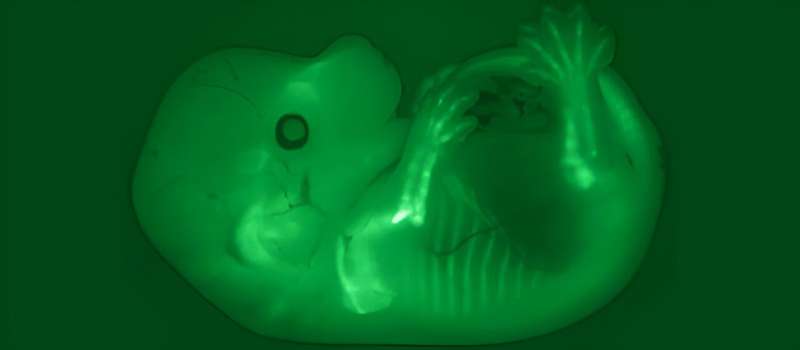This article has been reviewed according to Science X's editorial process and policies. Editors have highlighted the following attributes while ensuring the content's credibility:
fact-checked
peer-reviewed publication
trusted source
proofread
Scientists identify the genetic 'switches' of bone growth

Scientists at the UNIGE have identified the genetic sequences that regulate the activity of the genes responsible for bone growth.
In mammals, only 3% of the genome consists of coding genes which, when transcribed into proteins, ensure the biological functions of the organism and the in-utero development of future individuals. But genes do not function alone. They are controlled by other sequences in the genome, called enhancers, which, like switches, activate or deactivate them as required.
A team from the University of Geneva (UNIGE) has identified and located 2,700 enhancers—among millions of non-coding genetic sequences—that precisely regulate the genes responsible for bone growth.
This discovery sheds light on one of the major factors influencing the size of individuals in adulthood, and explains why their failure could be the cause of certain bone malformations. The results are published in Nature Communications.
Tall or short, our height is largely inherited from our parents. Furthermore, many genetic diseases affect bone growth, the exact cause of which often remains unknown. What if an explanation could be found not in the genes themselves, but in other parts of the genome responsible for activating them?
Guillaume Andrey, assistant professor in the Department of Genetic Medicine and Development at the UNIGE Faculty of Medicine and at the Geneva Institute of Genetics and Genomics (IGE3), who led this research, explains, "Short DNA sequences—known as enhancers—give the signal for transcription of DNA into RNA, which is then translated into proteins. While the genes that regulate bone formation and their location in the genome are already well known, it is not the case for the switches that control them."
Fluorescent bones
Andrey and his team have developed an innovative experimental technique, rewarded in 2023 with the Swiss 3R Competence Center Prize, which makes it possible to obtain mouse embryos carrying a precise genetic configuration from murine stem cells.
"In this case, our mouse embryos have fluorescent bones that are visible by imaging, enabling us to isolate the cells of interest to us and analyze how the enhancers work during bone development," explains Fabrice Darbellay, a post-doctoral researcher in Professor Andrey's laboratory and first author of this work.
The team monitored the activity of chromatin, the structure in which DNA is packaged, specifically in fluorescent bone cells. Using markers of gene activation, the scientists were able to identify precisely which regulatory sequences came into action to control the genes responsible for building bone. They then confirmed their discovery by selectively deactivating the enhancers without affecting the coding gene.
"We then observed a loss of activation of the genes in question, which indicates both that we had identified the right switches and that their role is indeed crucial to the proper functioning of the gene," explains Darbellay.
Three-dimensional mapping
Of the 2,700 switches identified in mice, 2,400 are found in humans. "Each chromosome is a long strand of DNA. Like pearls on a necklace, the enhancers and the genes they control form little balls of DNA on the same chromosomal thread. It is this physical proximity that enables them to interact in such a controlled way," explains Andrey.
Variations in the activity of these regions could also explain the differences in size between human beings: the activity of bone cells is indeed linked to the size of bones and therefore of individuals.
Moreover, many bone diseases cannot be explained by a mutation affecting the sequence of a known gene. The answer could be found elsewhere, and more precisely in the non-coding but regulatory regions of the genome.
"There are already a few documented cases where a mutation in the switches rather than in the genes themselves is the cause of bone disease. It is therefore very likely that the number of cases is underestimated, especially when the patients' genes appear normal," the authors explain. And beyond bone disease, failures of these various, as yet little-understood genetic switches could be the cause of many other developmental pathologies.
More information: Fabrice Darbellay et al, Pre-hypertrophic chondrogenic enhancer landscape of limb and axial skeleton development, Nature Communications (2024). DOI: 10.1038/s41467-024-49203-2




















